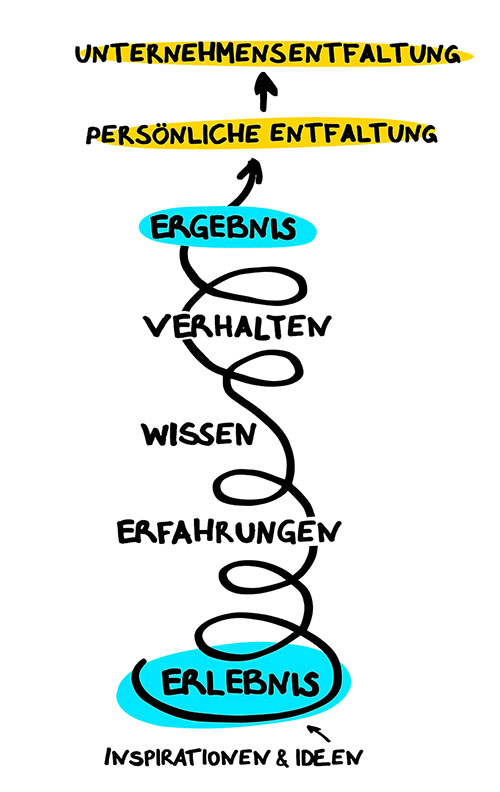Bucket list method: From experience to results
Are you living the life you really want – including at work?
This seemingly personal question is becoming increasingly important for companies. After all, organisations are not made up of organisational charts, but of people. People with aspirations, ideas, goals and the desire to make a real impact.
This is exactly where the buckett list method comes in. It activates personal potential and connects it to the professional role. This leads to development on both an individual and a corporate level.
What is the bucket list method?
The bucket list method is a structured development process that focuses on lived experiences rather than theoretical knowledge. It motivates people to leave their comfort zone, consciously seek out extraordinary experiences and reflect on them. This results in new perspectives, greater self-confidence and genuine transformation.
It is not just about spectacular life dreams, but about conscious decisions: How do I want to live, work and make an impact? What is essential in my life – and in my organisation? Especially in times of constant change, people and organisations need orientation, and this comes from conscious experience, reflection and personal clarity.
In an increasingly dynamic world of work, the ability to reflect on oneself is becoming a key competence.
The Bucket List Method specifically promotes this ability by focusing not only on the ‘what’ of the experience, but also on the “why” and ‘how.’ This meta-level makes experiences effective drivers of development.
But how exactly does an experience become a result? The path follows five powerful steps that make inner development visible and effective to the outside world:
The spark ignites: It all starts with an idea, often triggered by an external impulse. Those who take this moment seriously and take action experience something that stands out from everyday life and remains in their memory.
Experiences shape us: They become personal milestones. Experiences that go beyond the familiar challenge us and allow us to grow.
Experiences become knowledge: Reflecting on experiences creates deeply rooted, lived knowledge. It is more tangible than theoretical knowledge and has a more lasting effect.
Knowledge changes behaviour: Those who have experienced for themselves what is possible think and act differently. More courageously. More clearly. More authentically. This creates a new attitude – towards oneself, the team and the company.
Results through development: The end result is a person with more self-confidence, motivation and perspective. A person who makes an impact – in their own life and in the company.
From experience to results. The question is: Where can you find inspiration for yourself or your company? And what could be your next step to get started?
How does the buckets list method work in organisations?
Organisations can only grow if the people within them grow and if they are in love with their own lives. Happy, self-confident people are more creative, committed and resilient. When organisations promote this development, it results in a new sense of togetherness with positive effects on leadership, culture and customer experiences.
Companies that enable their employees to develop personally stand out clearly in the labour market. The integration of the bucket list method can be positioned as part of employer branding, for example in recruiting, at internal events or in management development.
This is particularly evident in three areas where the method repeatedly proves its effectiveness:
1. Meaning and motivation
Employees develop a deeper understanding of the ‘why’ behind their actions and experience their professional work as part of their life journey.
2. Cultural development through genuine connection
Teams that share values, dreams and goals experience stronger connection, trust and cooperation.
3. Personal development as a future skill
Those who regularly experience and reflect consciously make better decisions for themselves, for others and for the company.
This is how the bucket list method works in thinking, attitude and action. But how does this manifest itself in concrete terms? What do such areas of development look like in everyday company life? A look at practical examples provides answers.
The bucket list method in practice
Transformation needs space. And tools that invite people to enter this space. A central ‘tool’ of the bucket list method is the bucket list card game. It was developed to provide personal impetus, encourage reflection and make development tangible. For individuals as well as for teams and organisations, for coaches or managers
The card game contains over 500 experience prompts that specifically encourage you to question your own routine, try new things and sharpen your personal goals. Each card offers a thematic introduction, supplemented by motivating questions, initial steps for action and an online landing page with further content such as book recommendations, videos or experience reports. It is not a classic game, but a starting point for deeper conversations, new perspectives and real change.
These different but equally effective application examples show how this works in practice:
- A manager uses the card game in one-to-one coaching with her employee to identify new goals and gain clarity about her role in the company.
- A company integrates the method into onboarding processes to welcome new employees not only professionally but also personally.
- A team uses the method to regularly reflect on individual and joint development steps, thereby experiencing greater focus, connection and innovative strength.
- In transformation processes, the card game creates space for emotional involvement as a lever for sustainable change.
- In leadership programmes, the card set is used to sharpen personal visions and align them with company goals.
These examples show that the bucket list method is not an abstract theory. It is a living process. It works where people have the courage to take an honest look, allow questions to be asked and explore new paths. The card game is a powerful tool for this. Inspiring, flexible and deeply effective.

Conclusion: Development begins with an experience
The bucket list method links personal experiences with organisational development. It encourages people to break new ground and helps them to realise their potential. For companies, this means greater motivation, greater clarity and better results. In other words, when people flourish, companies flourish too.
Because when people are not just functioning, but inspired, it changes not only their own world, but also the culture and performance of entire organisations. This is precisely where the power of the bucket list method lies. It turns a list of dreams into a strategic tool: for cultural development, for leadership, for creating meaning and, ultimately, for change in a working world that is more dependent than ever on real experiences and emotional connection.
The bucket list method is not about escaping reality, but about conscious self-management, and that is precisely the skill that will make the difference in the future.
In addition, the principle of lifelong learning is practised in a new, experience-oriented way: learning through experience, through real action, reflection and application. This form of development is not only more sustainable, but also more enjoyable and therefore more motivating than traditional seminar concepts.
The method is also particularly effective in interdisciplinary teams where different perspectives come together. The personal experiences create a space in which communication is not only professional, but also human. This builds bridges and strengthens cohesion.
An often overlooked aspect is the sustainability of development measures. Many programmes fail because they provide isolated impulses without really touching people emotionally. The bucket list method, on the other hand, builds on genuine emotional experiences and anchors development not only in the mind but also in the heart. This is why many people still talk about a particular experience months later and describe it as a turning point.
Notes:
Further information on the bucket list method can also be found on the highly individual and informative website of Thomas Fleischanderl. There you will find numerous offers such as the card game or a development novel. And if you prefer to listen rather than read, then the podcast Impulse für dein Leben – Geschichten aus dem Alltag (Impulses for your life – stories from everyday life) is the right place for you.
If you like the article or would like to discuss it, please feel free to share it in your network. And if you have any comments, please do not hesitate to send us a message.

Thomas Fleischanderl
Thomas Fleischanderl is an entrepreneur, author, lecturer and bucket list creator. He is co-founder of the renowned online agency eMAGNETIX and has 15 years of experience as a managing director. In addition, he has repeatedly contributed his knowledge as a lecturer and advisor at the University of Applied Sciences and has led international business and adventure trips.
Both professionally and privately, he has been pooling his diverse experience and networks for years and is always on the lookout for new inspiration and challenges outside the mainstream. Among other things, he has set a world record and qualified for a world championship. His passion for extraordinary experiences is also reflected in his projects, such as the bucket list card game, adventure trips and the Bucketlist Schmiede. He learns from some of the most renowned coaches and the ‘university of life’ and passes on his experiences in inspiring lectures and talks.
In the t2informatik Blog, we publish articles for people in organisations. For these people, we develop and modernise software. Pragmatic. ✔️ Personal. ✔️ Professional. ✔️ Click here to find out more.